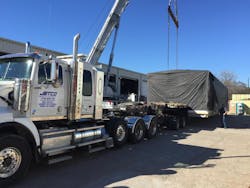With trucking insurance firms hiking premiums 10% to 30% in the wake of big claims, and with major companies such as Zurich Insurance Group AG and American International Group Inc. exiting the for-hire insurance market, it’s suddenly much tougher – and much more expensive – for truckers to obtain adequate coverage.
This follows a two-year effort by the Federal Motor Carrier Safety Administration (FMCSA) to raise minimum insurance coverage amounts to $750,000, with new food transportation requirements due for implementation next year opening the door to more liability exposure for trucking companies as well.
In short, the risk exposure is suddenly a whole lot bigger for motor carriers, which is not a good thing as our ever-more litigious society is putting trucking firmly in its legal crosshairs.
But in a chat with Brian Fielkow this week, the CEO of Jetco Delivery, I learned a few other things, too; namely that it’s not necessarily the big jury verdicts that is making truck insurance coverage so costly.
“What’s really driving cost in the system are the $25,000 to $50,000 settlements; the ones that aren’t worth the investment to take to court,” he told me – courts cases that, in many instances, a trucking company could actually win.
“To me it’s the frivolous litigation that’s really driving cost in the [insurance] system,” Fielkow said. “Ultimately, the consumer is going pay for that because as insurance rates rise, we [trucking] will need higher rates.”Yet he stressed something else as well: higher insurance minimums and closer scrutiny of trucking safety are actually good trends, though they’d better if tort reforms were part and parcel of it as well (“But I don’t see that on the horizon any time soon,” Fielkow added).
“You know, $750,000 [the minimum insurance amount for trucking companies established by the FMCSA] is not a lot of money when compared the cost of crashes,” he explained. “Even if they raised it to $1 million it wouldn’t much when compared to the [jury] verdicts we’re seeing.”
In Fielkow’s view, all of these factors are combining to place a renewed emphasis on how trucking mitigates risk – and, in his view, that translates into a motor carrier’s safety culture.
“Safety is not just the right thing to do; it’s a bottom line business proposition,” he stressed. “We’re talking about a great return in terms of dollars and cents beyond just your insurance premium costs.”
For example, Jetco installed in-cab video systems in all of its trucks two years ago not just because video can provide “proof of innocence” in crash situations but also allows Fielkow’s company to continually improve its safety profile through coaching.
“First and foremost it’s a coaching tool; our drivers make a thousand decisions every day and sometimes those decisions need to be corrected,” he explained. “It’s not about disciplining drivers and writing them up for mistakes; it’s about how we help them get better – it’s taking a ‘fair’ driver and making them ‘great.’”
That approach dovetails with what insurance firms want to see as well, Fielkow believes.
“Their interest is in risk control, in preventing accidents,” he said. “They want to know what are doing to prevent losses, not how claims will be paid.”
That’s also why Fielkow thinks that, instead of worrying about insurance costs directly, trucking firms need to focus on building a solid “safety culture,” which should, as a byproduct, deliver to them lower premiums.
“Sometimes we think talk about ‘safety culture’ is just a ‘feel good’ exercise, but it’s not; it delivers hard-core bottom line benefits,” he stresses. “No amount of rules and regulation will deliver safety improvements.”
To that end Fielkow offers three basic safety culture principles to keep in mind:
- Safety must be a core value: Fielkow said that while many motor carriers may make safety a “priority,” he stressed that “priorities can change. By contrast, a core value stays constant.” He added that safety should be “non-negotiable,” in that no matter what conditions are placed on a load of freight, it must be transported safely from the start or not transported at all. “Productivity cannot trump safety,” Fielkow said.
- Leadership must walk the walk: “You can’t have a CEO talk about the importance of safety and then, when there’s a customer problem, turn around and basically throw everything he just said out the window,” he stressed. “You have to back up safety-first decisions.”
- You must empower your front line: “They make all the safety decisions and they need to know they can call something out if it doesn’t look right,” Fielkow emphasized.
And as the trucking insurance market gets tighter and expensive, focusing on such fundamentals might offer a way to help mitigate premium hikes – if those fundamentals result in measureable reductions in loss claims, of course.

